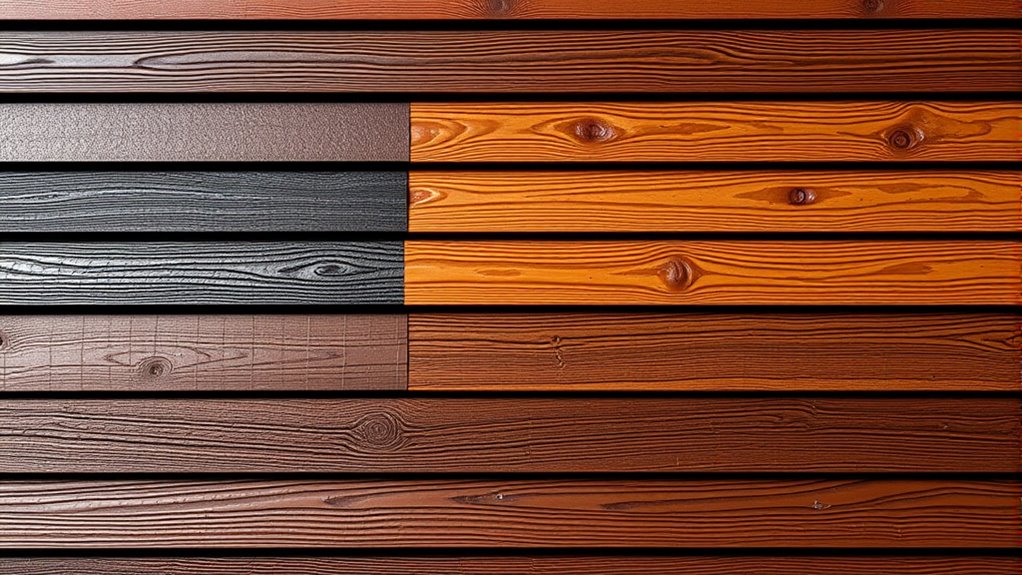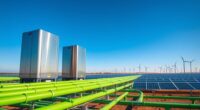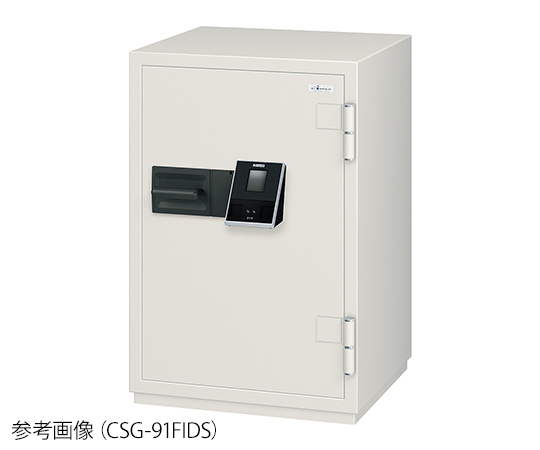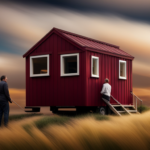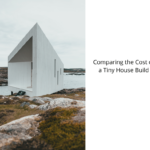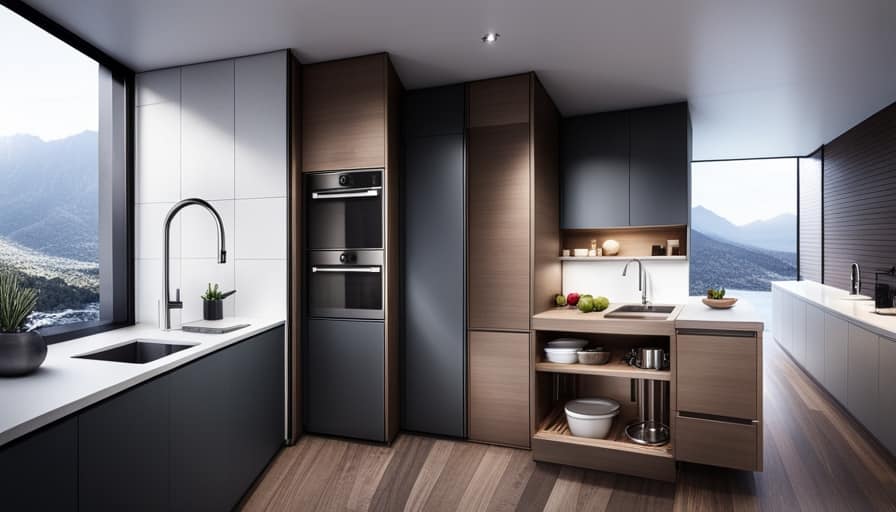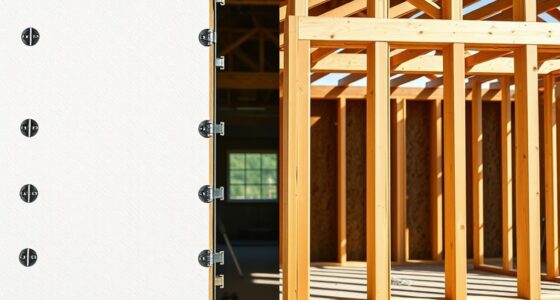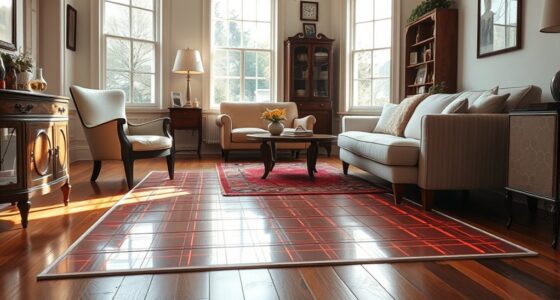If you’re ranking fire-resistant siding options by R-value and cost, consider that fiber cement offers low R-values (around 0.37–0.41) but provides excellent fire protection and costs roughly $5-$14 per square foot. Metal siding also has low R-values but is highly fire-resistant and durable at similar costs. Stucco and brick provide natural fire resistance with moderate costs, while insulated vinyl offers higher R-values (~3.5–5) but less fire resistance. Learning more will help you find the best balance for your needs.
Key Takeaways
- Metal siding, such as steel, provides high fire resistance with R-values up to 2 and generally falls within moderate to high-cost ranges.
- Fiber cement siding offers low R-values (~0.37–0.41) but excels in fire resistance, with costs from $5 to $14 per sq ft.
- Insulated vinyl siding combines decent R-values (3.5–5) with fire resistance up to 750°F at a relatively lower cost.
- Brick and stone veneers have minimal R-values but are naturally fireproof; costs vary from $8 to over $17 per sq ft.
- Stucco siding has low R-values but provides good fire resistance, with costs typically between $6 and $10 per sq ft.
Overview of Fire-Resistant Siding Materials
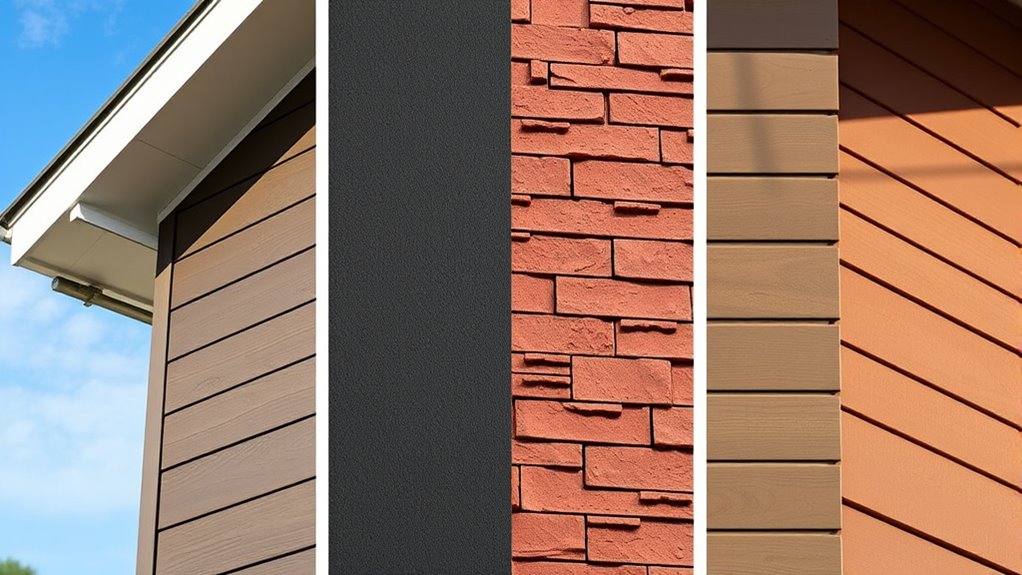
When choosing siding for fire-prone areas, understanding fire-resistant materials is essential. You’ll find options like fiber cement, metal, brick, stucco, and stone, all noncombustible and designed to resist flames and moisture. Fiber cement siding, such as Hardie Plank, offers a Class A fire rating and doesn’t serve as fuel for fires, making it popular in wildfire zones. Metal siding is durable, resistant to high winds and hail, and provides excellent fire protection with minimal maintenance. Brick and stone are naturally fire-resistant, enduring high temperatures and adding durability. Stucco provides a dense, noncombustible coating over framing, often used in wildland urban interface zones. These materials resist ignition, reduce fire spread, and often enhance your property’s value. Additionally, understanding the contrast ratio of these materials can help evaluate their effectiveness in fire scenarios.
Fire Resistance Ratings and Standards for Siding
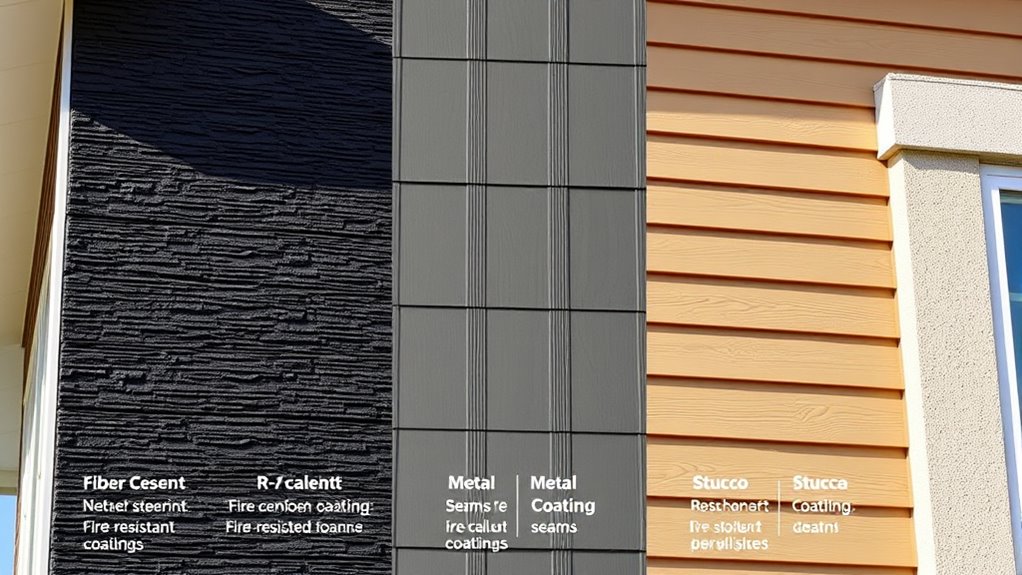
Understanding fire resistance ratings and standards for siding is essential to ensure your home withstands flames and reduces fire risk. Standards like ASTM E84 evaluate how surfaces spread flames and produce smoke, with lower flame spread index (FSI) and smoke developed index (SDI) indicating better fire resistance. ASTM E2957 assesses wildfire resistance, focusing on preventing fire penetration in eaves and soffits. California’s SFM Standard 12-7A-1 requires exterior walls to resist a 10-minute flame exposure or be noncombustible. Materials like fiber cement, metal siding, and stucco are non-combustible, while fire-retardant-treated wood is ignition-resistant. Class A ratings signify low flame spread and minimal smoke, meeting the highest fire safety standards, especially in wildfire-prone areas. These ratings are verified through specific testing procedures, and compliance guarantees your siding adheres to local and state fire safety requirements. Additionally, understanding fire-resistance ratings helps homeowners select materials that best protect their property and meet safety standards.
Comparative Fire Resistance and R-Values of Common Materials
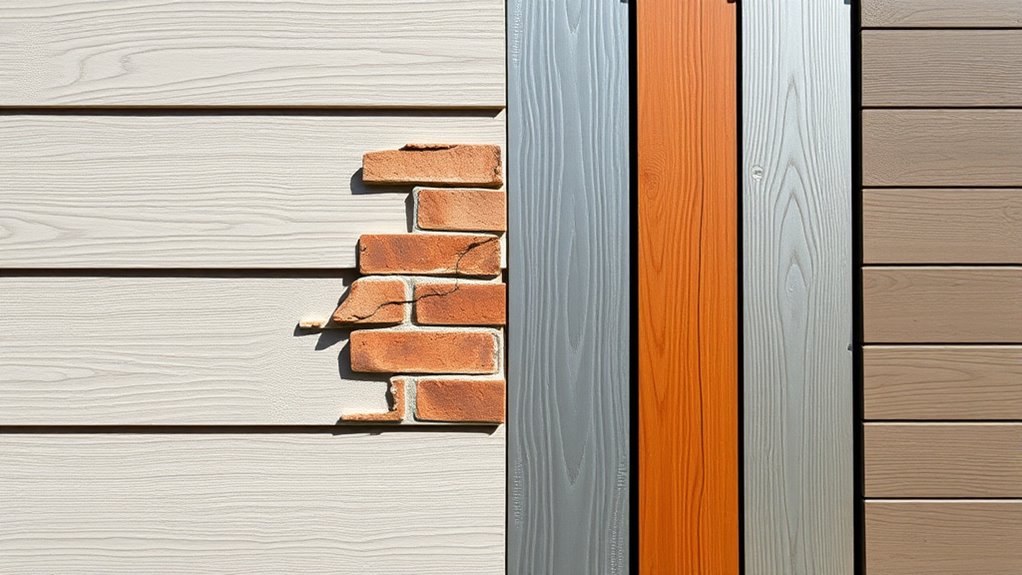
The fire resistance ratings and R-values of siding materials directly impact your home’s safety and energy efficiency. Insulated vinyl siding offers a decent R-value of 3.5–5 and resists fires up to 750°F, making it a cost-effective option with moderate fire resistance. Fiber cement siding provides a low R-value of around 0.37–0.41 but excels in fireproofing, withstanding intense wildfires and possibly reducing insurance costs. Wood siding has a higher R-value (0.81–1.25) but is less fire-resistant unless treated, posing higher fire risks. Metal siding ranks among the best for fire resistance, with R-values up to 2, and withstands flames better than other materials. Fire-resistant materials like fiber cement and metal are crucial in areas prone to wildfires. Understanding material properties is essential for making an informed decision. Balancing fire resistance with insulation is essential to selecting the best siding for your safety and energy needs.
Cost Analysis of Fire-Resistant Siding Options
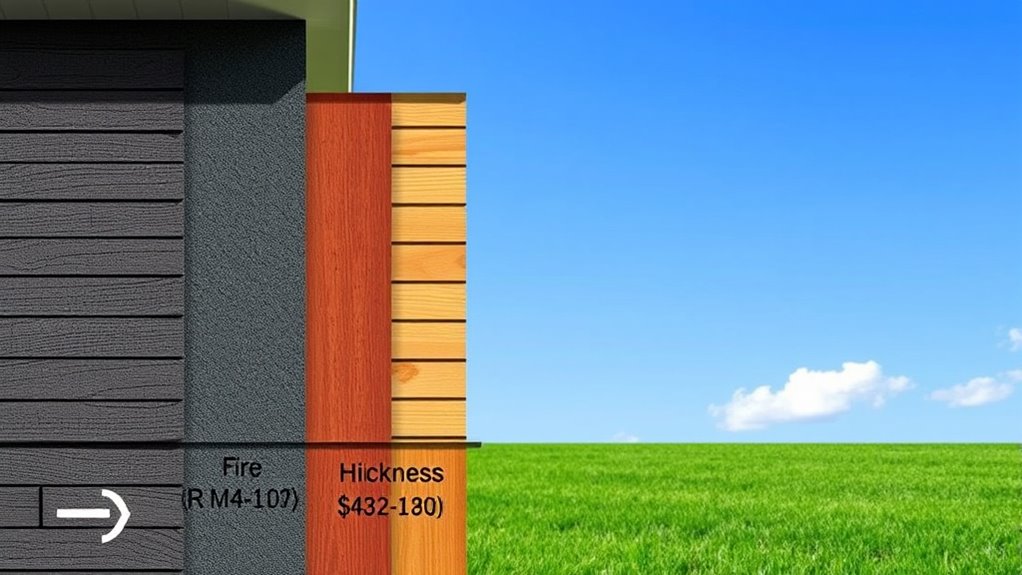
Choosing fire-resistant siding involves balancing durability and cost, as prices can vary markedly across materials. Fiber cement siding typically costs between $5 and $14 per square foot, with an average project around $14,674 for a 1,500-square-foot home. Installation labor ranges from $2 to $8 per square foot, influenced by complexity. Using fiber cement can reduce wildfire-related costs by about substantially 25%, saving roughly $12,190 compared to cedar plank siding. Other options like brick veneer ($8–$13 per sq ft) and stone veneer ($8.50–$17.50 per sq ft) offer durable, lower-maintenance choices at moderate costs, while full brick or stone siding can reach $21.50 to $38.75 per square foot. Overall, material quality, installation difficulty, and home size considerably impact total expenses. Cost differences can be significant depending on the chosen material and complexity of installation, further influencing the overall expense. Additionally, considering fire-resistant properties can help optimize safety and long-term savings when selecting siding options.
Advantages and Disadvantages of Key Fire-Resistant Siding Types
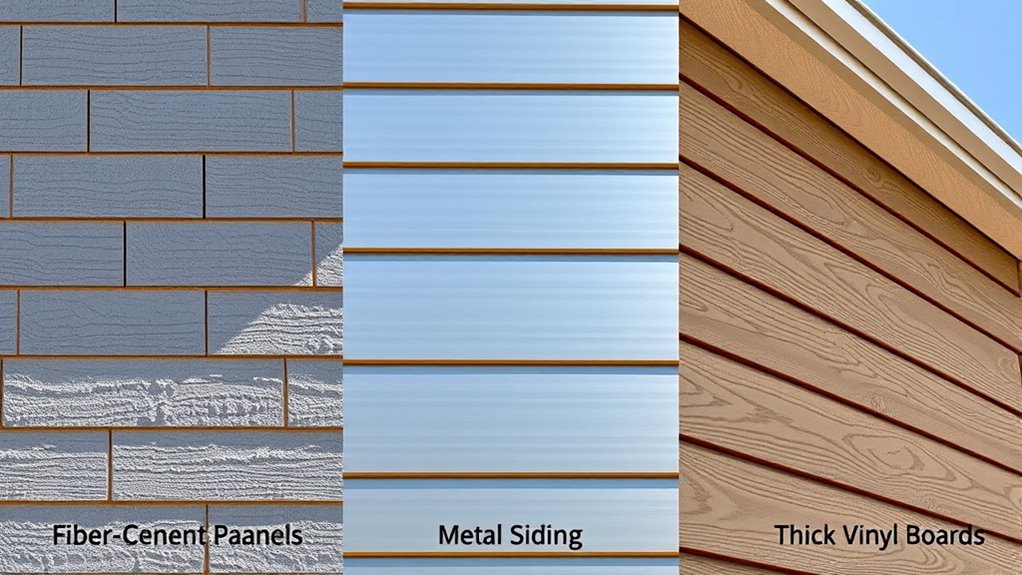
Fire-resistant siding options each offer unique benefits and challenges that can influence your choice. Steel siding provides a Class A fire rating, resists melting and warping, and withstands extreme weather—plus, it can mimic wood for aesthetic appeal. However, it’s prone to denting and has lower insulation value. Steel siding is also non-combustible, making it highly resistant to fire spread. Fiber cement siding also offers a Class A fire rating, looks like wood, and is durable, but it’s heavier, more expensive, and requires regular maintenance to prevent moisture damage. Hardie Plank, a fiber cement product, enhances fire resistance, adds safety, and looks attractive, though installation costs are higher. Stucco and stone veneers are non-combustible, durable, and cost-effective over time, but they can crack without proper upkeep. Treated wood resists ignition but remains combustible, offering a natural appearance with less fire resistance.
Practical Factors for Choosing Fire-Resistant Siding

When selecting fire-resistant siding, practical considerations go beyond fire safety ratings to include design flexibility, cost, and installation logistics. You’ll find materials like fiber cement offer a wide range of textures, colors, and customization options, fitting various architectural styles. Brick and stone provide durability and a classic look but come with higher costs and complex installation requirements, often needing specialized labor and support. Consider the long-term savings from reduced maintenance and potential insurance discounts. Weight and support needs also influence installation time and complexity. Ensuring compliance with local building codes is essential. Additionally, evaluate environmental impacts and safety for occupants, choosing materials that balance fire resistance with sustainability and health considerations. Fire-resistant siding can help contain damage and enhance safety during a fire incident, making it a valuable part of your overall fire safety strategy. Incorporating fire safety ratings into your decision-making process ensures you select the most effective and reliable options for protecting your property.
Final Considerations for Fire-Resistant Siding Selection
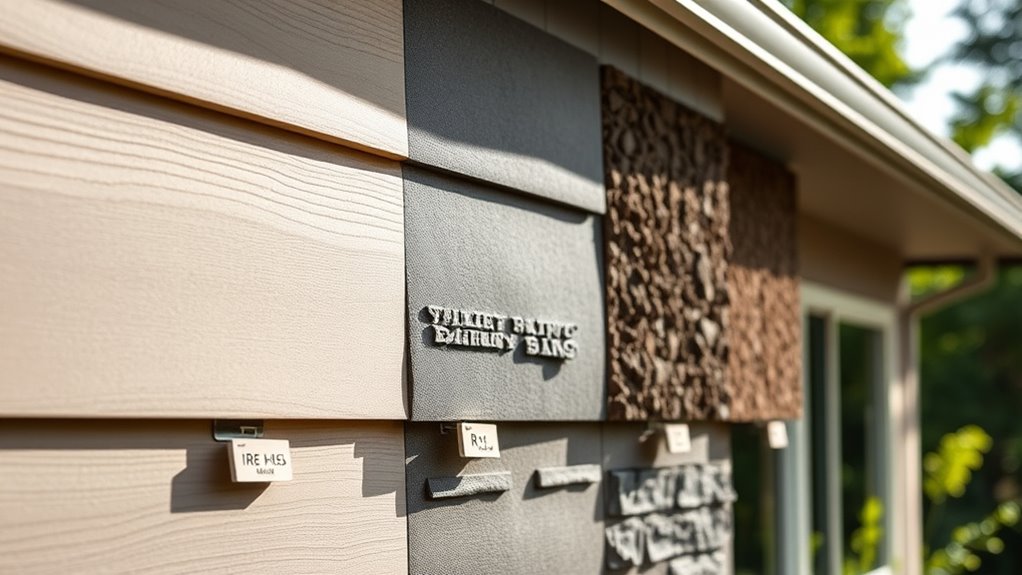
Ensuring your siding meets all necessary fire safety standards is crucial for protecting your home and complying with local regulations. Look for materials certified under recognized tests like ASTM E84, ASTM E2957, and NFPA 285, especially if you’re in wildfire-prone areas. Fiber cement and metal siding are among the most reliable options for high fire resistance, making them suitable choices for such regions. In regions with high wildfire risk, prioritize fiber cement or metal siding, which resist flames and prevent fire penetration. Proper installation and routine maintenance are critical to maintaining fire resistance over time. Fire-resistant materials can also help reduce the risk of fire spread and damage. While fiber cement and metal may cost more initially, they offer superior durability and lower long-term costs, including insurance savings. Consider regional building codes and environmental factors when choosing your siding. Balancing safety, aesthetics, and budget ensures you select a fire-resistant material that provides lasting protection and peace of mind.
Frequently Asked Questions
How Do Fire-Resistant Sidings Perform in Extreme Wildfire Conditions?
In extreme wildfire conditions, your fire-resistant siding, like Hardie® fiber cement, performs well by resisting ignition and limiting fire spread. It won’t ignite or add fuel, even during prolonged flames, but vulnerabilities exist at siding joints or cracks. While it can withstand typical wildfire flame durations, its effectiveness depends on proper installation and surrounding vegetation. Overall, noncombustible siding greatly enhances your home’s wildfire resilience.
Are There Eco-Friendly Fire-Resistant Siding Options Available?
You’ll find many eco-friendly fire-resistant siding options available. Materials like bamboo thermo, reclaimed wood, cork, and fiber cement combine sustainability with fire safety. Recycled metal and composite sidings also offer durability with minimal environmental impact. These options often require low maintenance and avoid toxic chemicals, helping you protect your home and the environment simultaneously. By choosing these sustainable materials, you support eco-conscious building practices without sacrificing fire resistance.
What Are the Maintenance Requirements for Different Fire-Resistant Sidings?
When considering fire-resistant sidings, you need to understand their maintenance needs. Wood siding with fire-resistant coatings requires regular reapplication and inspections for cracks or damage. Fiber cement siding needs periodic repainting and sealing to keep it moisture-resistant. Steel siding demands minimal upkeep, mainly cleaning to prevent rust. Overall, fire-resistant materials generally need less maintenance than traditional wood, but routine inspections and cleaning are key to maintaining their protective qualities.
How Does Siding Installation Impact Overall Fire Safety?
Have you considered how installation influences fire safety? Properly installed siding creates tight seals, preventing gaps that embers or flames can exploit. It also guarantees fire barriers are effective, reducing the risk of fire spreading through wall cavities. When you secure siding correctly, you minimize firebrand generation and vulnerability around windows and vents. Isn’t your home’s safety worth investing in quality installation techniques that complement fire-resistant materials?
Can Fire-Resistant Siding Improve Home Insurance Premiums?
You might see lower insurance premiums when you upgrade to fire-resistant siding because it reduces your home’s risk of fire and weather damage. Insurance providers often offer discounts for durable, non-combustible materials like fiber cement or metal siding, especially if your home is in a wildfire-prone area. Confirm with your insurer, but generally, investing in fire-resistant siding can lead to significant savings and increased safety.
Conclusion
Choosing fire-resistant siding is like selecting armor for your castle—you want strength, affordability, and peace of mind. By balancing R-values and costs, you craft a fortress that shields your home from danger without breaking the bank. Remember, no single material is perfect; it’s about finding the right fit for your needs. With careful choices, you’ll build a resilient home that stands tall and safe against the fiercest threats.
I’m Theodore, and I love tiny houses. In fact, I’m the author of Tiny House 43, a book about tiny houses that are also tree houses. I think they’re magical places where imaginations can run wild and adventures are just waiting to happen.
While tree houses are often associated with childhood, they can be the perfect adult retreat. They offer a cozy space to relax and unwind, surrounded by nature. And since they’re typically built on stilts or raised platforms, they offer stunning views that traditional homes simply can’t match.
If you’re looking for a unique and romantic getaway, a tree house tiny house might just be the perfect option.
